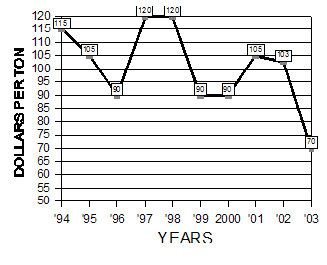Alfalfa Report
Yuma County, Arizona
December 29, 2003
Yuma County Office
2200 W. 28th Street, Ste. 102
Yuma, AZ 85364
(928) 726-3904
(928) 726-8472 FAX
Production Update:
Seedling Cold damage: Alfalfa seedlings are thought to
be the most sensitive to cold damage at the cotyledon stage before any
true leaves have formed. While this may be the case under artificial conditions,
in reality, the opposite seems to be true: alfalfa in the cotyledon stage
is rarely damaged by cold. The temperature of the plant leaf during a
cold night may be warmer than air temperature a few feet above the soil
surface. A broad leaf near the soil surface may intercept heat from the
soil and maintain a temperature above air temperature.
Insect Management: Blue alfalfa aphid (picture)
is a serious pest during the winter and spring months in the low desert.
Blue alfalfa aphid is distinguished from pea aphid (
picture)
by uniformly dark antennae. Pea aphids have lighter antennae with dark
bands at each joint (
picture).
The blue alfalfa aphid first appears in December or January when it may
be more abundant than pea aphid. Both species are common throughout the
spring, but pea aphid is more heat tolerant and may persist into early
summer. In susceptible alfalfa varieties, blue alfalfa aphid may stunt
grown and infested plants have smaller leaves, shorter internodes, leaf
curling, yellowing, and leaf drop. Several species of predacious bugs
and parasitic wasps attack these aphids. Sample alfalfa fields weekly
when aphids appear, then every 2 to 3 days as numbers approach the treatment
threshold of 40 to 50 blue alfalfa aphids per stem.
Weed Control: Freezing temperatures will cause crop injury but
is necessary to kill summer annual weeds such as sprangletop and sandbur.
Some summer annuals are selectively killed only by freezing temperatures.
| Market Summary |
High
|
Low
|
Average
|
Off grade
|
| Past 2 Weeks (Dec. 16 - Dec. 29, 2003) |
80
|
60
|
70
|
55-60
|
| Last Year (Dec. 16 - Dec. 29, 2002) |
105
|
95
|
103
|
70-90
|
10 Year Summary (Dec. 15 - Dec. 29, 1994-2003):

Issued in furtherance of Cooperative Extension work, acts of May 8 and June 30, 1914, in cooperation with the U.S. Department of Agriculture, James A. Christenson, Director Cooperative Extension, College of Agriculture and Life Sciences, The University of Arizona.
The University of Arizona is an equal opportunity, affirmative action institution. The University does not discriminate on the basis of race, color, religion, sex, national origin, age, disability, veteran status, or sexual orientation in its programs and activities.
Any products, services, or organizations that are
mentioned, shown, or indirectly implied in this web document do not imply
endorsement by The University of Arizona.
Information provided by:
Barry Tickes, btickes@ag.arizona.edu Extension Agent, Yuma County
Michael Ottman, mottman@ag.arizona.edu Agronomy Specialist
College of Agriculture, The University of Arizona.
Eric Natwick, etnatwick@ucdavis.edu UCCE Imperial County - Farm Advisor
University of California, Davis, CA.
Forages: Crop Mgmt | Soil Mgmt | Irrigation | Alfalfa Reports | Insects | Diseases | Weeds | Pesticides
Home | Other Crops | Forages
For more Arizona Production Ag Information:
Home | Cotton | Veggies| Forages | Grains | Citrus | Crop x Crop | Insects | Diseases| Weeds | Pesticides | News | Weather | Research | Photos | Contacts | General Info. | Site Map
Copyright © 2001 University of Arizona,
College of Agriculture and Life Sciences
Webmaster: Al Fournier (fournier@ag.arizona.edu)